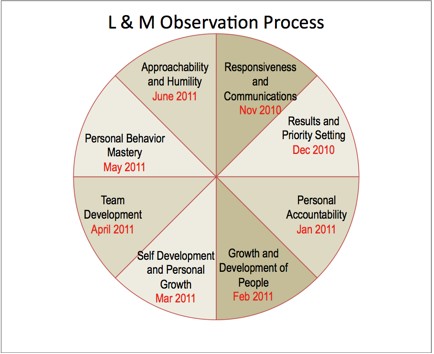Sort Articles:
Measuring Success in Leadership (Part 2): Getting Results and Setting Priorities
Written by: Ralph Twombly
Published: December 2010

Last month we began the journey of measuring success in leadership by introducing you to the first of eight sections considered important in successful leaders. Responsiveness and Communications was our first category and we overviewed the skill and behavioral sets necessary for success and received positive feedback from many and encouragement to keep going. If you missed last month's article, it is not too late to see it. Go to http://aprioritylearning.com/articles/measuring_success_in_leadership.php if you want to catch up.
This month I would like to take you to the second category. Results and Priority Setting is defined by successful leaders as knowing what is expected through routine checks, hitting those expectations, communicating expectations to others and holding accountable those who report to you. Determining what is most important and accomplishing results in a way that is aligned with the entire organization's needs.
As we mentioned last time, this month and for months to come we invite you into the discussion. The categories above and the skills sets and behavioral sets below come from our own observations of successful leaders. We don't claim to have all the answers or to even have all the right categories. We do, however, get better, smarter, and faster when you add to the discussion. That said, here we go.
Results and Priority Setting - Back in the late 90s, I knew and had lots of interaction with the head of HR for a local branch of one of the country's foremost manufacturers in the greater New England area. This HR professional was brilliant. We know this because, if quizzed, this person could answer almost anything asked in that vast realm of HR knowledge. This category of knowledge is enormous and anyone who has spent time in the HR world knows that the exponential rate of new and vital information is startling. There is bad news here also. This head of HR unfortunately was destined to lose his job and did. What happened? The head of HR needed more than knowledge to be a successful leader. Plagued by lack of organization, missing vital commitment dates, setting inappropriate priorities and missing critical delegation skills helped him to became the poster child for “all fluff and no stuff” to his colleagues. As his personal credibility started to wane people began to go around him, not include him and eventually he became the brunt of stories between managers about not being dependable and accountably. At first, the absent minded professor thing worked, but eventually in a highly productive and dynamic workplace he began to be a drag on others' productivity and effectiveness. Other managers started to “carry” him and in time that got tiring and eventually created resentment and even anger. The behavior of the head of HR set off a chain of events that eventually made him ineffective.
If you followed last month's display of skills and behaviors, the one below will be different and the model will be familiar. The matrix is broken down into four columns: On the left is a column for a forced rating, followed by a skill column, followed by a behavior column, and, finally, another forced rating column. The forced rating columns on each end are for self evaluation or rating by a superior. The skill column lists out observable things that make it easier for leaders to communicate. The behavior column is a list of motives or less than observable things but equally important factors for success.
Here is our skills and behavior matrix for Results and Priority Setting.
Skills and Behaviors Matrix
| Forced Rate: | Skill | Behavior | Forced Rate: |
| Organizing systems in place | Sharing communications | ||
| Delegating | Inspiring action from others | ||
| Priority setting | Handling change issues | ||
| Communicating with other depts. | Patience with others | ||
| Hitting deadlines | Approachability |
Use the scale of 1 being low and 5 being high, have some fun and give yourself a 1-5 rating for each skill in the left hand column and rate yourself for each behavior in the right hand column. If you need some help, ask others to provide some feedback. Below are the definitions for each section of the skills and behaviors.
Results and Priority Setting Skills Defined:
| Organizing systems in place - Leaders and managers find effectiveness in taking an existing system and making it work to the advantage of their area of responsibility. This ability at working with “what is” defines many leaders. This skill coupled with the ability to handle and lead change eases the minds of followers and makes for smoother, more predictable results. |
| Delegating - The recurring chuckle employees have between each other sometime goes, “Was that a delegation or a dump?” Delegation is both science and art and personal mastery not only increases a manager's effectiveness but heightens an employee's personal and organizational value. As a primary vehicle to create increased learning, agility in the workplace and flexibility for people, managers and leaders need to know the delegation process and create consistency in delegation. |
| Priority setting - Leaders need to be expert at setting priorities daily and sometimes hourly. Too often we hear that I don't have the time and find out later that it is less about time and more about what we place as our highest priority. To be good at choosing the thing or things that give you and your organization the best chance at success is essential. |
| Communicating with other departments - Reaching out to others with you and your team's best ideas, information that may aid them or simply be foundational for their work is critical in the success of leaders. When done properly and consistently the leader/manager's credibility goes up and so does their effectiveness. If done right, the leader/manager has a solid system for communications that can be applied routinely. |
| Hitting Deadlines - Meeting the deadline is the minimum expected from leaders/managers. When deadline management skills are applied, the leader/manager is routinely early personally and creates a mindset in their area of responsibility that on time means NOT missing the deadlines. Get great at this category and everyone concerned will sleep better at night. |
Results and Priority Setting Behaviors Defined:
| Sharing communications - What differentiates this from other communication categories is the element of “willfulness”. Willfully sharing is not tactical and may or may not have an easily defined outcome. The will to share is seen by others as characteristic of trustworthy, loyal colleagues. |
| Inspiring action from others - Inspiration comes from personal belief and displays of energy. People follow people who “believe” and when the leaders/managers roll up their sleeves and demonstrate that belief system, it becomes contagious. We are finding that this behavior is not seen by top leaders of companies as optional anymore. This is part of what companies expect from their managers and leaders. |
| Handling change issues - Change is a way of life in every organization. Change is the only real constant in any business, either profit based or working in the non or not for profit world. The leader's ability to eliminate resistance, overcome objection and transition individuals and teams to a continuously changing environment is vital to personal success. |
| Patience with others - Someone said that “Patience is a virtue. Virtue is a grace and both put together make a very “pretty face” and we agree mostly with the patience part. Each day we start again and we expect that leaders will be ahead of the people they work with and sometimes for. With this as a constant in work life your only real remedy is patience. Patience with those to learn and catch up, to grow each day to make mistakes and learn from those mistakes. It is all part of the behavioral pattern of good leaders/managers. |
| Approachability - If people are unwilling to approach you, you will have no followers. When people don't feel your embrace, they will be reluctant to come to you with ideas, concerns, and barriers to effectiveness or any of the things that make work life collaborative. Over time your value will diminish because we as leaders are in one business and that business is the people business. If customers stop buying our goods and services, we are out of business and, if people cannot approach their leaders, they in essence will go “out of business.” |
Based on how you did when you self rated yourself in the categories above, you can start a plan for growth that may help you become better at Results and Priority Setting. Next month we take a look at Personal Accountability.
Again, please give me some feedback. Next month I will be back to break down the skills and behaviors for you. Please have a Happy Hanukkah and very Merry Christmas. Here comes 2011!!
Ralph Twombly
In the 20 years since starting Priority Learning, Ralph has facilitated countless learning experiences and has conducted training for thousands of managers and leaders. With over 30 years of leadership development and organizational development background and work, Ralph continues to build relationships with client companies all over the U.S.

